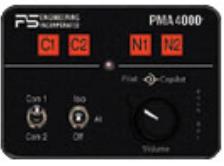Bill_H
I love flying!
I have Skyview systems in both an RV12 and a Glasair 2 that I own, so I am familiar with the architecture and installation.
A friend just bought a GlaStar with an old panel. He then bought a bunch of Skyview equipment from an abandoned project, much of it new in the box. Good stuff! So I'm going to help him.
It includes 2 D-1000, one SV2S intercom, and one SVC25 radio. (And a lot more - Dual ADAHRS, transponder, adsb, AP servos... etc.) The plane has an existing Garmin SL 40 com he wants to keep. There will be NO (VOR) NAV radios with an audio OUT signal from them (e.g., morse identifier). There will be an IFR GPS-only navigator, again, no audio out from it except maybe alerts.
So here is the Audio Panel question (and I have read every audio panel thread!) The Installation manual does show a transmitter selector switch for using the intercom with two different radios, with the thought of also fooling with the volume controls at the same time. (I don't like that latter bit.) Bob Nuckolls shows a SPDT transmitter selector switch switch used for similarly switching the mic-and-ptt-to-radio signal.
Could a similar switch be placed on the AUDIO FROM both radios to feed INTO ONE input of the SV intercom? A RECEIVER Selector switch? That is, switching from COM 1 to COM2 would involve throwing TWO switches and not adjusting volumes? (And likely the switches could be tied together OR a different switch type could be used to combine these.)
Since no NAV radio audio sources will be needed (and no marker beacon), this seems like a significantly cheaper solution than wiring in an audio panel.
If this is feasible, is there a preference for the switches as make-before-break or make-after-break?
And why is this "not recommended" and would doing it in this manner eliminate the "transmitter interlock functionality" issue? Seems it would since the other com would not be heard when the switch is thrown.


A friend just bought a GlaStar with an old panel. He then bought a bunch of Skyview equipment from an abandoned project, much of it new in the box. Good stuff! So I'm going to help him.
It includes 2 D-1000, one SV2S intercom, and one SVC25 radio. (And a lot more - Dual ADAHRS, transponder, adsb, AP servos... etc.) The plane has an existing Garmin SL 40 com he wants to keep. There will be NO (VOR) NAV radios with an audio OUT signal from them (e.g., morse identifier). There will be an IFR GPS-only navigator, again, no audio out from it except maybe alerts.
So here is the Audio Panel question (and I have read every audio panel thread!) The Installation manual does show a transmitter selector switch for using the intercom with two different radios, with the thought of also fooling with the volume controls at the same time. (I don't like that latter bit.) Bob Nuckolls shows a SPDT transmitter selector switch switch used for similarly switching the mic-and-ptt-to-radio signal.
Could a similar switch be placed on the AUDIO FROM both radios to feed INTO ONE input of the SV intercom? A RECEIVER Selector switch? That is, switching from COM 1 to COM2 would involve throwing TWO switches and not adjusting volumes? (And likely the switches could be tied together OR a different switch type could be used to combine these.)
Since no NAV radio audio sources will be needed (and no marker beacon), this seems like a significantly cheaper solution than wiring in an audio panel.
If this is feasible, is there a preference for the switches as make-before-break or make-after-break?
And why is this "not recommended" and would doing it in this manner eliminate the "transmitter interlock functionality" issue? Seems it would since the other com would not be heard when the switch is thrown.


